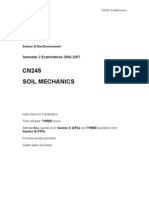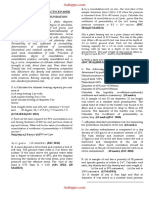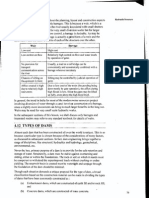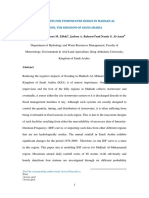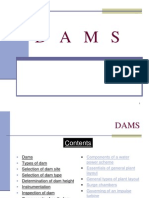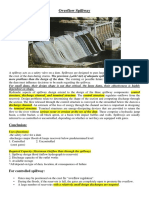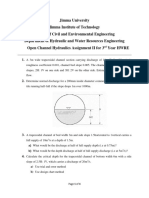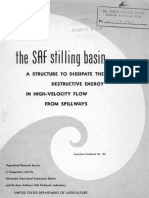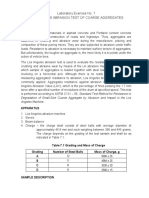Earthened Dams
Earthened Dams
Uploaded by
gopisrtCopyright:
Available Formats
Earthened Dams
Earthened Dams
Uploaded by
gopisrtOriginal Description:
Copyright
Available Formats
Share this document
Did you find this document useful?
Is this content inappropriate?
Copyright:
Available Formats
Earthened Dams
Earthened Dams
Uploaded by
gopisrtCopyright:
Available Formats
Untitled Document
EARTHEN DAMS
Modern developments in earth moving equipments have considerably reduced the cost of carriage and laying of the
dam materials.Earthen dams are cheaper as they can utilise the locally available materials, and less skilled labour is
required for them.
Earthen dams can be easily constrcuted on earth foundation.However, earth dams are more susceptible to failure as
compared to rigid dams.It is imortant to control the properties of the soil used for the construction.Continuous field
observations of deformations and pore water pressures have to be made during the construction of such dams.Suitable
modofications in the design are made during construction, depending upon the field observations.
TYPES OF EARTHEN DAMS :
1. Homogenous Embankment Type.
2. Zoned Embankment Type.
3. Diaphragm Type.
(1) Homogenous Embankment Type :
Eathen embankment consists of a single material and is homogenous throughout.A blanket of relatively impervious
material may be placed on the upstream face.Used for low to nmoderately high dams and for levees.
Fig.1a Homogeneous type embankment.
A purely homogenous section poses the problems of seepage, and huge sections are required to make it safe against
piping, stability,etc.Hence a homogenous section is generally added with an internal drainage system such as a
horizontal drainage filter or a rock toe.This keeps the phreatic line well within the body of the dam, allowing steeper
slopes.Hence smaller sections can be used.
file:///D|/dr.srini old system backup/d drive backup/ce303/rekha/chapters/Organisation/Chapter3dams/embankdam/types.htm[11/16/2010 4:25:26 PM]
Untitled Document
Fig.1b Homogeneous embankment provided with a drainage filter.
(2) Zoned Embankment Type :
Usually provided with a central impervious core, covered by a comparitively pervious transition zone, which is finally
surrounded by a much more pervious outer zone
The central core checks the seepage.The transition zone prevents piping through cracks which may develop in the
core.The outer zone gives stability to the central impervious fill and also distribute the load over a larger area of
foundations.
Fig.2 Zoned type embankment.
Clay, inspite of it being highly impervious, may not make the best core, if it shrinks and swells too much.Clay is
sometimes mixed with fine sand or fine gravel, so as to use it as the most suitable material for the central impervious
zone.Silts or silty clays may be used as the satisfactory central core materials.Freely draining material, such as coarse
sanda and gravels, are used in the outer shell.Transition filters are provided whenever there is an abrupt change of
permeability from one zone to another.
(3) Diaphragm Type :
Diaphragm type embankments have a thin impervious core, which is surrounded by earth or rock fill.The impervious
core,called diaphragm, is made of impervious soils,concrete,steel,timber or any other material.It acts as a water barrier
to prevent seepage through the dam.The diaphragm must also be tied to the bedrock or to a very impervious foundation
file:///D|/dr.srini old system backup/d drive backup/ce303/rekha/chapters/Organisation/Chapter3dams/embankdam/types.htm[11/16/2010 4:25:26 PM]
Untitled Document
material.If the thickness of the diaphragm at any elevation is less than 10 m or less than the height of the embankment
above the corresponding elevation, the dam embankment is considered to be of 'Diaphragm Type'.But if the thickness
equals or exceeds these limits, it is considered to be of zoned type embankment.
Fig.3 Diaphragm type embankment.
file:///D|/dr.srini old system backup/d drive backup/ce303/rekha/chapters/Organisation/Chapter3dams/embankdam/types.htm[11/16/2010 4:25:26 PM]
Untitled Document
Flow Net Analysis.
A considerable amount of seepage takes place in an earth dam through its foundations and in the dam body through the
porous and relatively impervious sandy clayey materials. To determine the amount of seepage, it is necessary to
determine the flow net which requires the integration of the Laplace equation based on darcy's Law for the seepage of
water through soil.
Seepage Theory
where f = -kh is the flow causing potential. If K is constant, f is a direct measure of the seepage
head.
Significance of Laplace Equation.
One set of lines represents the trajectories of seepage and is called Flow Lines. Between two adhacent flow lines is a
flow channel which conveys a fixed part of the total discharge. The other set is called Equipotential Lines which are
simply contours of equal head. The difference between any two adjacent equipotential lines is the potential drop or
head loss developed as seepage water flows through the flow channel.
The entire pattern of flow lines and equipotential line is termed as flownet ( Fig.1)
Fig.1 The flow net.
Properties of Flow Net Curves.
file:///D|/dr.srini old system backup/d drive backup/ce303/rekha/chapters/Organisation/Chapter3dams/embankdam/flownet.htm[11/16/2010 4:24:17 PM]
Untitled Document
In drawing the flow net for the earth dam following properties of the curves are to be noted.
1. The shape of the successive flow lines represents gradual transition from one to the other.
2. The flow lines and equipotential lines must intersect each other at right angles.
3. The flow lines must start and end at right angles to the ground surface upstream and downstream respectively.
4. If an upstream stratum does not exist, the flow line gradually adopts semi-elliptical shape.
5. The equipotential lines must start and end at right angles to the first and last flow lines respectively.
6. Every square obtained by the intersection of flow lines and equipotential lines is called a field.
7. If the curves are drawn properly, a circle can be drawn in each field which touches all the four sides of the fields.
In the light of the above properties, the flow lines and the equipotential lines in the flow net can be drawn in the body
of the dam and in the foundations. Fig.2 shows flow-net drawn for a homogeneous earth dam provided with a
horizontal drainage filter.
Fig.2 Flow net for seepage through homogeneous earth dam with horizontal drainage filter.
Phreatic Line
Phreatic line is the top flow line which separates saturated from unsaturated zone and below which positive hydrostatic
pressure exists in the dam section. Along the phreatic line, the atmospheric pressure exists. This line, whose position is
not influenced by the presence of pervious foundation, is always normal to the upstream face which represents 100 per
cent equipotential line. The subsequent equipotential lines meet the phreatic line at equal vertical intervals ( Dh ).
Similarly the subsequent flow lines are determined on the condition of equating the distance betwen the flow line with
that between the potential lines, thus forming a series of squares.( Fig.2 ).
Pore Pressure.
The soil mass comprises of solid particles, and voids filled with water and air. When the moist soil mass is loaded
without permitting water or air to escape, part of the load causes the soil grains to deform elastically without changing
their solid volume and is called the effective stress. The remaining part load is carried by the stress in the water and air
file:///D|/dr.srini old system backup/d drive backup/ce303/rekha/chapters/Organisation/Chapter3dams/embankdam/flownet.htm[11/16/2010 4:24:17 PM]
Untitled Document
contained in the voids and is known as the pore-water pressure or simply pore pressure.
Because the pore water pressure generally depends on the compressibility of the compacted soil and the amount of air
contained in it, greater pressures would result when the soils are compacted close to saturation. As such, it is a general
practice in the construction of high earth fill dam to compact the cohesive soils with water content brought below the
optimum moisture content of Proctor maximum dry density.
Considerable pore pressures develop during and after construction of an earth dam before filling of the reservoir.
Immediately on dam construction, the soil mass is under compresion due to the overlying fill and without proper
drainage of the compacted wet soil and as a result sizeable pure pressures develop. However, these are gradually
dissipated as the soil moisture is redistributed. As the reservoir is filled, water reenters the voids and a new pore
pressure head at any point is equal to the hydrostatic head due to the water in the reservoir less the head loss in
seepage through the dam to that point.
file:///D|/dr.srini old system backup/d drive backup/ce303/rekha/chapters/Organisation/Chapter3dams/embankdam/flownet.htm[11/16/2010 4:24:17 PM]
Untitled Document
Slope Stability Analysis
The usual failure of an earth dam consists in sliding of a large mass of soil along a curved surface.( Fig.1 )
Fig.1 Cross-section of failure by sliding
The stabaility of the earth dam is therefore determined by its ability to resist shear stress resulting from externally
applied loads such as reservoir and earthquake and from internal body force caused by the weight of the soil and the
dam slopes. The external and internal body forces also produce compressive stresses normal to the potential sliding
surface, which contribute both to the shearing strength of the soil as well as to the development of pore pressures.
Terzaghi found that the total stress normal to any plane is made up of an effective stress and a fluid pressure. Thus, the
total normal compressive stress is mathematically stated as
. . . Eqn.1
where s = normal compressive stress.
s' = effective stress
u = pore water pressure.
The shearing strength ( s ) along a plane is obtained from Coulomb's equation.
or
. . . Eqn.2
where c = Cohesion whose value for sand is taken as zero and for clay between 5 - 60 kN/m 2
f= Angle of internal friction
From Eqn.2 it may be inferred that the fractional portion of the resistance along a plane is reduced by pore water
pressure.
Various methods have been proposed for computing the stability of earth dams. In general, these methods are based on
the shearing strength of the soil and certain assumption with respect to the character of the embankment failure. The
Swedish or Slip Circle method suggested by Patterson, a Swedish engineer is the one most generally used.
Slip Circle Method
The basic method presumes the failure surface to be an arc of circle in cross-section. Moments are developed about the
file:///D|/dr.srini old system backup/d drive backup/ce303/rekha/chapters/Organisation/Chapter3dams/embankdam/slopestab.htm[11/16/2010 4:24:53 PM]
Untitled Document
circle centre, by the internal forces and external loads including the weight of the mass of soil, the force exerted by the
water pressure on the face of the slope, etc. These moments tend to cause overturning ( SM 0 ) and consequent failure.
The resisting moments ( SM r ) are provided by the shear resistance along the failure surface plus any resistence offered
by piling of structures which extend across the failure surface. The safety of the slope is given by the ratio of the
resisting to overturning moments which should be greater than 1.
In determining the stability of a proposed slope such as an embankment, it is necessary to try many different circles.
The circle which gives the minimum factor of safety is the most critical. The number of circles in practice is decided
by the past experience.
The basic analysis as described above is used for any soil where shear resistance is independent of the normal pressure
on the failure surface. In soils, where shear is affected by the confining pressure, the effective stress on each segment
of failure arc must be determined in order to compute the shear strength. Since no exact analysis for this is available,
various approximations are employed of which the method of slices is most reliable and widely used.
Method of Slices.
This assumes a condition of plain strain with failure along a cylindrical circle. Developed by Fellenius to compute the
normal pressure on the shear surface, the method consists in dividing the earth mass of the failure arc ( with an
assumed centre of arc ) into a number of vertical segments called slices ( Fig.2 ) and setting the forces acting on the
sides of each slice, equated to zero for equilibrium condition ( Fig.3 ).
Fig.2 Stability analysis by method of slices
The moment tending to rotate the soil mass about O is
. . . Eqn.3
where x1 , x2 , etc. are the moment arm of each segment.
The resisting moment is provided by the tangential shear stresses acting on the failure arc.
file:///D|/dr.srini old system backup/d drive backup/ce303/rekha/chapters/Organisation/Chapter3dams/embankdam/slopestab.htm[11/16/2010 4:24:53 PM]
Untitled Document
. . . Eqn.4
in which s = shear strength of the soil
L = length of failure arc for a segment
r= radius of the failure arc.
The shear strength of the soil is obtained by the use of Coulumb's equation i.e., Eqn.2.
Fig.3 Free body diagram of forces acting on a failure arc segment.
The stability of the dam is tested with the minimum factor of safety along the assumed failure of arc. This means
several possible failure arcs need to be tried. The factor of safety must, however, be more than one.
. . . Eqn.5
Example: An earth dam 24 m high is to be constructed from silt which is compacted at optimu moisture content at a
specific weight t = 1.9 kN/m 3 and cohesion = 5.80 kN/m 2 , angle of fraction f = 26.. The dam section has top width =
7.5 m, side slopes 1 on 2 both on upstream and downstream side and berm width = 3 m. Check the dam stability for the
condition that there is steady-state seepage with failure of arc of radius 40 m centered at a point having coordinates (
10, 40 ) with respect to the toe of the dam. Neglect pore water pressures.
Solution: We shall be using the method of slices to solve the problem.
Step 1. With the centre located at the given position, draw the failure arc at the radius of 40 m.
Step 2. Split the sliding mass of the failure arc into 6 equal segments. Determine the weight of each segment from the
plotted position of the dam sections and the moment arm of each segment from the centre of the failure arc. This is
indicated on columns 2 and 3 of Table 1.
Step 3. Determine the overturning moment M from the product of the weight of segment and the corresponding
moment arm. This is shown in Column 4.
Step 4. Determine W cos i.e the component of the weight of the segment which opposes the normal component N.
Also measure the length of the failure arc of segment ( column 5, 6 ).
file:///D|/dr.srini old system backup/d drive backup/ce303/rekha/chapters/Organisation/Chapter3dams/embankdam/slopestab.htm[11/16/2010 4:24:53 PM]
Untitled Document
Step 5. Calculate the effective stress
( column 7).
Step 6. Determine the shear strength of soil for the segment by adding the cohesive strength C to the tangent of the
angle of internal friction in accordance with Eqn.2 ( columns 8,9 ).
Step 7. Determine the resisting moment ( M r ) by use of Eqn.4 . ( column 10 ).
Step 8. Finally calculate the factor of safety by dividing the sum total of the resisting moment by the total of the
overturning moment. It is found that the factor of safety is 1.99 which satisfies the given Eqn.5 .
Hence the dam section is safe.
Table 1. Calculation for Overturning and Resisting Moments.
file:///D|/dr.srini old system backup/d drive backup/ce303/rekha/chapters/Organisation/Chapter3dams/embankdam/slopestab.htm[11/16/2010 4:24:53 PM]
Untitled Document
Types of Failure of Earthen Dams
1. Hydraulic failures
2. Seepage failures
3. Structural failures
Hydraulic failures :
About 40% of earth dam failures have been attributed to hydraulic failures. The failure under this category,may occur
due to the following reasons :
(a) By Overtopping :
The water may overtop the dam, if the design flood is under-estimated or if the spillway is of insufficient capacity or
if the spillway gates are not properly operated .Sufficient freeboard should be provided as an additional safety
measure.
(b) Erosion of upstream face :
The waves developed near the top water surface due to the winds, try to notch out the soil from the upstream face
and may even, sometimes, cause the slip of the upstream slope .Upstream stone pitching or riprap should,
therefore,be provided to avoid such failures.
Fig.1 Rollers due to wave action.
(c) Cracking due to frost action :
Frost in the upper portion of the dam may cause heaving and cracking of the soil with dangerous seepage and
consequent failure. An additional freeboard allowance upto a maximum of about 1.5 m may be provided for dams in
areas of low temperatures.
(d) Erosion of downstream face by gully formation :
Heavy rains falling directly over the downstream face and the erosive action of the moving water, may lead to the
formation of gullies on the downstream face, ultimately leading to the dam failure.This can be avoided by proper
maintenance, filling the cuts from time to time especially during rainy season, by grassing the slopes and by
providing proper berms ( Fig.2 ) at suitable heights, so that the water has not to flow for considerable distances.The
proper drainage arrangements are made for the removal of the rain water collected on the horizontal berms.
file:///D|/dr.srini old system backup/d drive backup/ce303/rekha/chapters/Organisation/Chapter3dams/embankdam/failure1.htm[11/16/2010 4:23:03 PM]
Untitled Document
Fig.2 Provision of Berms.
(e) Erosion of the d/s toe :
The d/s toe of the earth dam may get eroded due to cross currents that may come from the spillway buckets or due
to tail water.This erosion of the toe can be avoided by providing a d/s slope pitching on a riprap upto a height
slightly above the normal tail water depth.Side walls of the spillway (called diaphragm walls) must be of sufficient
height and length so as to prevent the possibility of the cross flow towards the earthen embankment.
Next
file:///D|/dr.srini old system backup/d drive backup/ce303/rekha/chapters/Organisation/Chapter3dams/embankdam/failure1.htm[11/16/2010 4:23:03 PM]
Untitled Document
Seepage Failures :
More than 1/3rd of the earth dams have failed because of seepage failures .Uncontrolled or concentrated seepage
through the dam body or through the foundations may lead to piping or sloughing and the subsequent failure of
the dam.
(a) Piping through foundations :
When highly permeable cavities or fissures or strata of coarse sand or gravel are present in the foundations of the dam
( Fig.3 ), water may start seeping at a huge rate through them.This concentrated flow at a high gradient may erode the
soil.This leads to increased flow of water and soil, ultimately resulting in a rush of water and soil, thus, hollows get
created below the foundations.The dam may sink down into the hollow so formed, causing its failure.
Fig.3 Piping through dam and foundation
(b) Piping through dam body :
When the concentrated flow channels get developed in the body of the dam, soil may be removed leading to the
formation of hollows in the dam body (Fig. 3), and subsequent subsiding of the dam. These flow channels may
develop due to faulty construction, insufficient compaction,cracks developed in embankment due to foundation
settlement, shrinkage cracks, animal burrows,etc. All these causes can be removed by better construction and better
maintenance of the dam embankments.
Piping through the dam body, generally gets developed near the pipe conduits passing through the dam body. Contact
seepage along the outer side of conduits may either develop into piping, or seepage through leaks in the conduits may
develop into piping.This can be avoided by thoroughly and properly compacting the soils near the outlet conduits
and by preventing the formation of cracks in the conduits. These cracks in the conduits are caused by differential
settlement and by overloading from the embankment.
(c) Sloughing of D/S toe :
The failure starts when the downstream toe becomes saturated and gets eroded, providing a small stump or a
miniature slide.The miniature slide leaves a relatively steep face ( Fig.4 ) which becomes saturated by the seepage
from the reservoir and slumps again, forming a more unstable surface.The process continues till the remaining portion
of the dam is too thin to withstand the horizontal water pressure, leading to the sudden failure of the dam.
file:///D|/dr.srini old system backup/d drive backup/ce303/rekha/chapters/Organisation/Chapter3dams/embankdam/failure2.htm[11/16/2010 4:23:22 PM]
Untitled Document
Fig.4 Downstream slide due to sloughing.
Previous Next
file:///D|/dr.srini old system backup/d drive backup/ce303/rekha/chapters/Organisation/Chapter3dams/embankdam/failure2.htm[11/16/2010 4:23:22 PM]
Untitled Document
Structural failures :
About 25% of the dam failures have been attributed to structural failures .Structural failures are generally caused by
failures,causing slides.
(a) Foundation slide :
When the foundation of earth dams are made of soft soils, such as fine silt,sort clay, etc, the entire dam may slide
over the foundations .Sometimes seams of fissured rocks,shales or soft clay, etc. may exist under the foundations
and the dam may slide over some of them, causing its failure.In this type of failures ( Fig.5 ), the top of embankment
gets cracked and subsides, the lower slope moves outward forming large mud waves near the heel.
Fig.5 Foundation slide
Excessive pore water pressure is confined seams of sand and silt, artesian pressure in abutments, or hydrostatic excess
developed due to consideration of clay seams embedded between sands or silts,etc. may reduce the shear strength of
the soil, until it becomes incapable of resisting the induced shear stresses, leading to the failure of dam foundations
without warning. Loose sand foundations may fail by liquefication of flow slides.
(b) Slide in Embankments :
When the embankment slopes are too steep for the strength of the soil, they may slide causing dam failure ( Fig.6
).The most critical condition of the slide of the u/s slope is the sudden draw-down of the reservoir and slope is
most likely to slide,when the reservoir is full ( Fig.7 ).
Fig.6 Failure due to sudden drawdown.
file:///D|/dr.srini old system backup/d drive backup/ce303/rekha/chapters/Organisation/Chapter3dams/embankdam/failure3.htm[11/16/2010 4:23:43 PM]
Untitled Document
The u/s slope failures seldom lead to catastrophic failures, but the d/s slope failures are very serious.These failures,
generally occur due to the development of excessive unaccounted pore pressures which may reduce the shearing
strength of the soils.Many embankments may fail during the process of consolidation, at the time of construction
or after the construction.
Fig.7 D/S slope slide during full reservoir condition.
(c) Flow slide: It occurs due to liquification of foundation soil comprising of loose sand or silt when the dam face
collapses on its foundation
(d) Spreading : When the earth dam is located on weak foundation comprising of stratified layers of soft soil, clay,
failure may occur through spreading of the embankment slope ( Fig.8 ).
Fig.8 Failure by spreading.
Previous
file:///D|/dr.srini old system backup/d drive backup/ce303/rekha/chapters/Organisation/Chapter3dams/embankdam/failure3.htm[11/16/2010 4:23:43 PM]
You might also like
- Gravity Dam1Document56 pagesGravity Dam1Mary Elizabeth AltaNo ratings yet
- CN245 Soil Mechanics: Semester 2 Examinations 2006-2007Document9 pagesCN245 Soil Mechanics: Semester 2 Examinations 2006-2007Owethu Malinga100% (1)
- CH 4 Soil Foundation - Auhippo - 1 PDFDocument8 pagesCH 4 Soil Foundation - Auhippo - 1 PDFPrachi SontakkeNo ratings yet
- Assignment On Stability Analysis of Embankment DamsDocument15 pagesAssignment On Stability Analysis of Embankment DamshabtamuNo ratings yet
- Lin in G of Irrigatio N Can Als An D Econ Omics of Lin Ing: Chapter No. 5 Santosh KumarDocument26 pagesLin in G of Irrigatio N Can Als An D Econ Omics of Lin Ing: Chapter No. 5 Santosh KumarUmer Waheed100% (1)
- Notes 3 - Soil Compressibility For Shallow FoundationsDocument61 pagesNotes 3 - Soil Compressibility For Shallow FoundationsSim Wen senNo ratings yet
- How To Calculate The Specific Capacity of A Well - Ground WaterDocument13 pagesHow To Calculate The Specific Capacity of A Well - Ground WaterSATVINDAR SINGHNo ratings yet
- Types of Dams Storage StructuresDocument4 pagesTypes of Dams Storage StructuresRaju ShresthaNo ratings yet
- Seepage in DamsDocument24 pagesSeepage in DamsReynaldo CruzNo ratings yet
- Slope Stability AnalysisDocument7 pagesSlope Stability AnalysisBindu SrirangamNo ratings yet
- 11 - Theories of Seepage and Design of Weirs and BarragesDocument90 pages11 - Theories of Seepage and Design of Weirs and BarragesYIBELTAL EBABU100% (1)
- DIVERSION-HEADWORKS and Seepage Theories-SlidesDocument93 pagesDIVERSION-HEADWORKS and Seepage Theories-SlidesUmesh RegmiNo ratings yet
- Hatem A. Ewea, Amro M. Elfeki, Jarbou A. Bahrawi and Nassir S. Al-AmriDocument34 pagesHatem A. Ewea, Amro M. Elfeki, Jarbou A. Bahrawi and Nassir S. Al-Amriayman_awadallahNo ratings yet
- Dams LecturesDocument51 pagesDams LecturesMuhammad AdeelNo ratings yet
- Contact Pressure: Elastic Properties of FootingDocument8 pagesContact Pressure: Elastic Properties of FootingdhivyaNo ratings yet
- CVNG 2003-Design II Culvert DesignDocument69 pagesCVNG 2003-Design II Culvert Designrajal11No ratings yet
- Floods:: Flood RoutingDocument18 pagesFloods:: Flood RoutingGetnet Girma100% (1)
- 1877 PDFDocument8 pages1877 PDFAhmed AlbayatiNo ratings yet
- A-Seepage-Model-Of-Gravity-Dam 1Document27 pagesA-Seepage-Model-Of-Gravity-Dam 1Renalyn Andrade0% (2)
- 7-CE-323 - Stream Flow Routing-Routing-ReservoirDocument10 pages7-CE-323 - Stream Flow Routing-Routing-ReservoirAtif KhanNo ratings yet
- Lacey's Regime TheoryDocument7 pagesLacey's Regime TheoryGaurav Balodiya100% (1)
- Case Study 5 - Scour RepairsDocument21 pagesCase Study 5 - Scour RepairsNOEL RODRIGUEZNo ratings yet
- Arch DamDocument26 pagesArch DamJostin P JoseNo ratings yet
- WR Lecture Notes 5 Water Resource Sediment TransportDocument48 pagesWR Lecture Notes 5 Water Resource Sediment TransportMouhamad Khaled AyachNo ratings yet
- CH 5 Cross DrinageDocument40 pagesCH 5 Cross DrinageAbuye HDNo ratings yet
- Influences On Selection of The Type of DamDocument13 pagesInfluences On Selection of The Type of DamDeybin RodriguezNo ratings yet
- Khosla TheoryDocument21 pagesKhosla TheorySUMA TADICHARLANo ratings yet
- Embankment DamDocument63 pagesEmbankment DamRanjan Dhungel100% (2)
- Ahe QBDocument20 pagesAhe QBNivedhitha CNo ratings yet
- ConsolidationDocument17 pagesConsolidationthak49100% (1)
- Indian Standard: Code of Practice For Stability Analysis of Earth DamsDocument41 pagesIndian Standard: Code of Practice For Stability Analysis of Earth DamssantkabirNo ratings yet
- G2.11 Reservoir PlanningDocument16 pagesG2.11 Reservoir PlanningJenny Moreno100% (2)
- Design Principles of Earth DamsDocument2 pagesDesign Principles of Earth DamsOladunni AfolabiNo ratings yet
- Dam Foundation Treatment: GroutingDocument27 pagesDam Foundation Treatment: GroutingZeleke TaimuNo ratings yet
- CE341 CE22 Wk03 4 Soil CompactionDocument143 pagesCE341 CE22 Wk03 4 Soil CompactionFaiaz Bin DelworNo ratings yet
- Water: Process, Supply and Use Sub Surface Hydrology (Groundwater)Document39 pagesWater: Process, Supply and Use Sub Surface Hydrology (Groundwater)fujiNo ratings yet
- Open Channel Hydraulics Worksheet 2Document4 pagesOpen Channel Hydraulics Worksheet 2Yasin Mohammad Welasma100% (1)
- CE458 Chapter 5Document72 pagesCE458 Chapter 5Mihai MihailescuNo ratings yet
- Well Hydraulics Notes Zhang 2014Document14 pagesWell Hydraulics Notes Zhang 2014Ricardo FigueiredoNo ratings yet
- Lecture 6 Arch - DamDocument25 pagesLecture 6 Arch - DamChanako DaneNo ratings yet
- Chapter Four Ogee SpillwayDocument21 pagesChapter Four Ogee Spillwayhabtamu100% (1)
- Calculation of Band DrainsDocument3 pagesCalculation of Band DrainsWan100% (1)
- 5 Seepage TheoriesDocument30 pages5 Seepage TheoriesSushil Mundel100% (1)
- CD WorksDocument35 pagesCD WorksThulasidharan Nair Bhaskaran100% (2)
- Zakho, Iraq Travel Weather Averages (Weatherbase)Document4 pagesZakho, Iraq Travel Weather Averages (Weatherbase)gazi shaikhNo ratings yet
- Dam and Reservoir: Geological InvestigationDocument19 pagesDam and Reservoir: Geological InvestigationGadige ChandraNo ratings yet
- Saint Anthony Falls (SAF Stilling Basin)Document16 pagesSaint Anthony Falls (SAF Stilling Basin)Henry Alvarez100% (1)
- Weir Dsign and LayoutDocument5 pagesWeir Dsign and LayoutBehar Abduraheman100% (1)
- LabEx No. 7 Los Angeles Abrasion TestDocument4 pagesLabEx No. 7 Los Angeles Abrasion TestianzkieeNo ratings yet
- Hydraulic JumpDocument17 pagesHydraulic JumpSuhaimi SamNo ratings yet
- Hydraulic Structure I - CENG 3161: Design Principle of DamsDocument152 pagesHydraulic Structure I - CENG 3161: Design Principle of DamsAbduljebar HussienNo ratings yet
- CE10CE - 4234failure of Earthen DamsDocument27 pagesCE10CE - 4234failure of Earthen DamssalilNo ratings yet
- Ensity Duration Frequency Curves: Presented by A S Suchithra M.Tech (Gis) K L UniversityDocument17 pagesEnsity Duration Frequency Curves: Presented by A S Suchithra M.Tech (Gis) K L Universitysuchi05 suchi05No ratings yet
- Clay BlanketDocument2 pagesClay BlanketAhmed Tarek100% (1)
- Merits of Embankment DamDocument4 pagesMerits of Embankment DamhanoseNo ratings yet
- NPTELDocument4 pagesNPTELSatyaprakash PrasadNo ratings yet
- CE 322 Assignment 1 - SolutionDocument13 pagesCE 322 Assignment 1 - SolutionNickson Koms100% (1)
- Chapter 7 Permeability Hydraulic ConductivityDocument73 pagesChapter 7 Permeability Hydraulic Conductivityjoemer cabayaoNo ratings yet
- Presentation On Geology and Soil Mechanics: Submitted By-Titiksha Negi B.Tech (Ce) 4 SEMDocument21 pagesPresentation On Geology and Soil Mechanics: Submitted By-Titiksha Negi B.Tech (Ce) 4 SEMTitiksha NegiNo ratings yet
- Gte Unit 3Document9 pagesGte Unit 3amol bardeNo ratings yet
- Tamhidi Et Al 2020 GM GPR EngrxivDocument15 pagesTamhidi Et Al 2020 GM GPR EngrxivgopisrtNo ratings yet
- Mechanical Systems and Signal Processing: L. Huras, Z. Zembaty, P.A. Bon Kowski, P. BobraDocument18 pagesMechanical Systems and Signal Processing: L. Huras, Z. Zembaty, P.A. Bon Kowski, P. BobragopisrtNo ratings yet
- Plagiarism Scan Report: Content Checked For PlagiarismDocument1 pagePlagiarism Scan Report: Content Checked For PlagiarismgopisrtNo ratings yet
- Jashn18Schedule Day 1Document1 pageJashn18Schedule Day 1gopisrtNo ratings yet
- WL WL: Irctcs E-Ticketing Service Electronic Reservation Slip (Personal User)Document2 pagesWL WL: Irctcs E-Ticketing Service Electronic Reservation Slip (Personal User)gopisrtNo ratings yet
- Truss InputDocument4 pagesTruss InputgopisrtNo ratings yet
- Ground Motion CharacteristicsDocument4 pagesGround Motion CharacteristicsgopisrtNo ratings yet
- Physics For Entertainment Volume 1Document212 pagesPhysics For Entertainment Volume 1gopisrt100% (2)
- ES: 624: Nonlinear Elasticity Homework - 2, Due Jan 27th: Ij I J Ij I J K K Ij K J K I Ij K JK I Ij J IDocument1 pageES: 624: Nonlinear Elasticity Homework - 2, Due Jan 27th: Ij I J Ij I J K K Ij K J K I Ij K JK I Ij J IgopisrtNo ratings yet
- Concrete BasicsDocument56 pagesConcrete Basicsengcecbepc100% (6)
- ''Ft'tdter T: Qo A14 Az (+Document22 pages''Ft'tdter T: Qo A14 Az (+gopisrtNo ratings yet
- CH8 Consolidation SoilMech - SettDocument45 pagesCH8 Consolidation SoilMech - SettAkoNo ratings yet
- PLAXIS-3D Dam StabilityDocument20 pagesPLAXIS-3D Dam Stabilityjimmysatanco100% (1)
- Geotechnical Engineering RRLDocument21 pagesGeotechnical Engineering RRLLeBron JamesNo ratings yet
- Mcegs 103 Advanced Soil MechanicsDocument4 pagesMcegs 103 Advanced Soil MechanicsTantai Rakthaijung100% (1)
- Evolution of The Factor of Safety Following Excavation in ClayDocument7 pagesEvolution of The Factor of Safety Following Excavation in ClayNik GreekNo ratings yet
- Electro Mechanical Training by WAYUMADocument26 pagesElectro Mechanical Training by WAYUMAKumale DiribsaNo ratings yet
- Validation of Soil Parameters For Deep Tube Tunnel AssessmentDocument13 pagesValidation of Soil Parameters For Deep Tube Tunnel AssessmentSérgio BernardesNo ratings yet
- Unsaturated Soil Mechanics: Fundamental Challenges, Breakthroughs, and OpportunitiesDocument9 pagesUnsaturated Soil Mechanics: Fundamental Challenges, Breakthroughs, and OpportunitiesgeotecnhniqueNo ratings yet
- Chapter 4 - Groundwater Flow and Seepage.v1Document104 pagesChapter 4 - Groundwater Flow and Seepage.v1فرج محمد زيدانNo ratings yet
- Triaxial Test: Consolidated UndrainedDocument9 pagesTriaxial Test: Consolidated UndrainedNguyễn Hòa100% (1)
- 6 Flow Nets - Course NoteDocument11 pages6 Flow Nets - Course NoteMate HazayNo ratings yet
- Geotech 1Document5 pagesGeotech 1JeremiahNo ratings yet
- Direct Shear Test of Soils Under Consolidated Drained ConditionsDocument9 pagesDirect Shear Test of Soils Under Consolidated Drained ConditionsKoppolu SrinivasuluNo ratings yet
- Natural Dredging SLopeDocument4 pagesNatural Dredging SLopeDudu DuduNo ratings yet
- Smith Et Al 2021. A Generalised CPTu State Parameter Inversion Method Based On The NorSand WidgetDocument10 pagesSmith Et Al 2021. A Generalised CPTu State Parameter Inversion Method Based On The NorSand WidgetChristian RebataNo ratings yet
- PLAXIS 2D 2018 Tutorial Lesson13Document9 pagesPLAXIS 2D 2018 Tutorial Lesson13Khaled Abdel SalamNo ratings yet
- Expansive Soils, Problems and Practice in Foundation and Pavement EngineeringDocument284 pagesExpansive Soils, Problems and Practice in Foundation and Pavement EngineeringTobias Nevarez87% (15)
- Case Study of The Changi East Land Reclamation Project SingaporeDocument13 pagesCase Study of The Changi East Land Reclamation Project SingaporeVictoria JungNo ratings yet
- Pore Pressure TerminologyDocument4 pagesPore Pressure TerminologyAna AraújoNo ratings yet
- Seepage AnalysisDocument113 pagesSeepage AnalysisAriel B. LumacadNo ratings yet
- Consolidation Practicum Report - Soil MechanicsDocument26 pagesConsolidation Practicum Report - Soil MechanicsShiela Ariesta EfendiNo ratings yet
- Consolidation of SoilDocument44 pagesConsolidation of SoilHarpreet Singh100% (1)
- CVEN90050 Geotechnical Engineering: Paper NOT To Be Lodged With Baillieu LibraryDocument16 pagesCVEN90050 Geotechnical Engineering: Paper NOT To Be Lodged With Baillieu LibraryANo ratings yet
- Advanced Triaxial Tests On Partially Saturated Soils Under Unconfined ConditionsDocument18 pagesAdvanced Triaxial Tests On Partially Saturated Soils Under Unconfined ConditionsTufail Ahmad KhanNo ratings yet
- Settlement and Consolidation, 1-25-00Document5 pagesSettlement and Consolidation, 1-25-00lawan100% (1)
- Bh3 Ud2 Bh3 Ud2 Group ReportDocument7 pagesBh3 Ud2 Bh3 Ud2 Group ReportS Azhar ATNo ratings yet
- FHWA Dynamic Compaction Manual PDFDocument109 pagesFHWA Dynamic Compaction Manual PDFcepi herdiyanNo ratings yet
- PressureDocument2 pagesPressureYè PaingNo ratings yet
- SHANSEP - Stress History and Normalized Soil Engineering PropertyDocument11 pagesSHANSEP - Stress History and Normalized Soil Engineering PropertyJavier Andres Martinez OrtegaNo ratings yet

